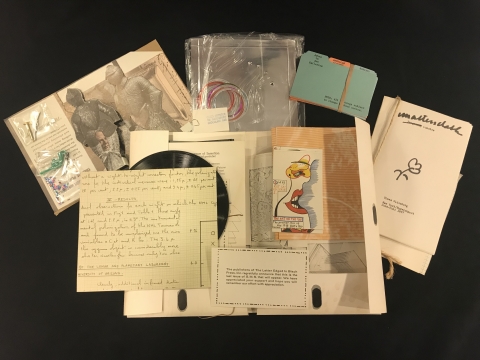S.M.S., No. 6
Category: Preserve for the Future
Location: Hirshhorn Museum and Sculpture Garden Library
S.M.S., No. 6, December 1968
The S.M.S. portfolios were a collaboration between late Surrealist artists William Copley (friends with and gallerist to Dada artists Man Ray, Duchamp, Max Ernst, etc.) and Dmitri Petrov, which they published through their Letter Edged in Black Press. The project involved some of the most important artists of the twentieth century, and exemplified the community ethos of the 1960s. Both the Dada movement, and the Fluxus movement that followed it, did not agree with the authority of museums to determine the value of art, nor did they believe that one must be educated to view and understand a piece of art. S.M.S., or “Shit Must Stop,” bypassed traditional institutions to distribute artists’ work directly to their audience. Six portfolios containing eleven to thirteen objects were produced in editions of 2000. Ironically, today these works are highly valued and prized by museum collections.
Listen to a recording of an anonymous voice reading a letter to the editor in Astrophysical Journal while browsing the sixth and final edition of S.M.S. Bernar Venet’s interest in Cold War science is pushed to the edge in his piece Astrophysics in which he appropriated scientific documents to create a record along with a cover designed on graph paper. Additional artists in this edition include Dieter Roth, Mischa Petrov, and Paul Steiner.
This is a mid 20th century artists portfolio housed in the original box, as mailed to the subscriber. The portfolio consists of elements created by thirteen different artists. There is also a guide to the box, titled "Sequence of Insertion." The elements include prints in plastic sleeves, rolodex-shaped printed cards, a 33 RPM record, and a knight paper doll. The original box bears a label addressed to Mr. Al Lerner as well as the original metered postage label. Conservators will repair many elements, such as items with fold-over edges. They will then create separate housing for each of the items. These will include Mylar L-sleeves, acid free enclosures, and a large double-tray box to house all of the elements together.
Discover more about this book in our Catalog.

